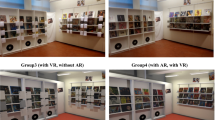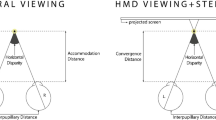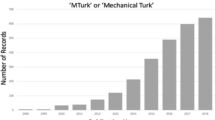Abstract
On-body input interfaces that can be used accurately without visual attention could have a wide range of applications where vision is needed for a primary task: emergency responders, pilots, astronauts, and people with vision impairments could benefit by making interfaces accessible. This paper describes a between-participant study (104 participants) to determine how well users can locate e-textile interface discrete target touch points on the forearm without visual attention. We examine whether the addition of active touch embroidery and passive touch nubs (metal snaps with vibro-tactile stimulation) helps in locating input touch points accurately. We found that touch points towards the middle of the interface on the forearm were more difficult to touch accurately than at the ends. We also found that the addition of vibro-tactile stimulation aids in the accuracy of touch interactions by over 9% on average, and by almost 17% in the middle of the interface.
















Similar content being viewed by others
Data availability
De-identified data may be available upon request.
References
Ashbrook DL, Clawson JR, Lyons K, Patel N, Starner T (2008) Quickdraw: the impact of mobility and on-body placement on device access time. Proceedings of CHI 2008. pp 219–222. https://doi.org/10.1145/1357054.1357092
Bergstrom-Lehtovirta J, Boring S, Hornbæk K (2017) Placing and recalling virtual items on the skin. Conference on Human Factors in Computing Systems - Proceedings, pp 1497–1507. https://doi.org/10.1145/3025453.3026030
Castano LM, Flatau AB (2014) Smart fabric sensors and e-textile technologies : A review. Smart Mater Struct 23. https://doi.org/10.1088/0964-1726/23/5/053001
Cholewiak RW, Collins AA (1995) Vibrotactile pattern discrimination and communality at several body sites. Percept Psychophys 57(6):724–737. https://doi.org/10.3758/BF03213276
Craig JC, Evans PM (1987) Vibrotactile masking and the persistence of tactual features. Perception & Psychophysics 42(4):309–317. https://doi.org/10.3758/BF03203085
Dunne L, Profita H, Zeagler C (2014) Social aspects of wearability and interaction. In: Sazonov E, Neuman M (eds) Wearable sensors: Fundamentals, implementation and applications. Elsevier Inc, pp 25–43
Dunne LE, Profita H, Zeagler C, Clawson J, Gilliland S, Do EY-L, Budd J (2014) The social comfort of wearable technology and gestural interaction. 2014 36th Annual International Conference of the IEEE Engineering in Medicine and Biology Society. EMBC 2014
Gemperle F, Kasabach C, Stivoric J, Bauer M, Martin R (1998) Design for wearability. Digest of Papers. Second International Symposium on Wearable Computers
Gibson J (1962) Observations on active touch. Psychological Review 69(6):477–491. https://doi.org/10.1037/h0046962
Gilliland S, Komor N, Starner T, Zeagler C (2010) The textile interface swatchbook: Creating graphical user interface-like widgets with conductive embroidery. IEEE International Symposium on Wearable Computers, ISWC, Seoul, South Korea 20(10):1–8
Gustafson S, Rabe B, Baudisch P (2013) Understanding palm - based imaginary interfaces : The role of visual and tactile cues when browsing. CHI
Hamdan NAH, Blum JR, Heller F, Kosuru RK, Borchers J (2016) Grabbing at an angle: Menu selection for fabric interfaces. ACM International Symposium on Wearable Computers, ISWC, Heidelberg, Germany, pp 1–7
Harrison C, Tan D, Morris D (2010) Skinput : Appropriating the body as an input surface. CHI 453–462
Hart SG (2006) Nasa-Task Load Index (NASA-TLX); 20 years later. Proc Hum Factors Ergon Soc Annu Meet 50(9):904–908. https://doi.org/10.1177/154193120605000909
Jacquard by Google: https://atap.google.com/jacquard/. Accessed 22 Dec 2020
Komor N, Gilliland S, Clawson J, Bhardwaj M, Garg M, Zeagler C, Starner T (2009) Is it gropable?–assessing the impact of mobility on textile interfaces. IEEE International Symposium on Wearable Computers, ISWC, Linz, Austria, pp 71–74
Lee S (2012) Buzzwear: Supporting multitasking with wearable tactile displays on the wrist. Georgia Institute of Technology
Lin S-Y, Su C-H, Cheng K-Y, Liang R-H, Kuo T-H, Chen B-Y (2011) PUB - Point Upon Body : Exploring eyes-free interaction and methods on an arm. UIST 2011:481–487
Loomis JM, Lederman SJ (1984) What utility is there in distinguishing between active and passive touch. Psychonomic Society Meeting, San Antonio, Texas
Lopes P, Ion A, Mueller W, Hoffmann D, Jonell P, Baudisch P (2015) Proprioceptive Interaction. Proceedings of the 33rd Annual ACM Conference on Human Factors in Computing Systems, Seoul, South Korea, pp 939–948
Marculescu D, Marculescu R (2003) Electronic textiles: A platform for pervasive computing. Proceedings of the IEEE 91(12):1995–2018
Molla TI, Goodman S, Schleif N, Berglund ME, Zacharias C, Compton C, Dunne LE (2017) Surface-mount manufacturing for E-textile circuits. International Symposium on Wearable Computers Maui, Hawaii, pp 18–25
Ni T, Baudisch P (2009) Disappearing mobile devices. Proceedings of the 22nd annual ACM symposium on User interface software and technology, Victoria, BC, Canada, pp 101–110
Nolan MF (1982) Two-point discrimination assessment in the upper limb in young-adult men and women. Physical Therapy 62(7):965–969
Oakley I, Kim Y, Lee J, Ryu J (2006) Determining the feasibility of forearm mounted vibrotactile displays. Proceedings - IEEE Virtual Reality 2006:74. https://doi.org/10.1109/VR.2006.49
Olwal A, Moeller J, Priest-Dorman G, Starner T, Carroll B (2018) I/O braid: Scalable touch-sensitive lighted cords using spiraling, repeating sensing textiles and fiber optics. UIST 2018 - Proceedings of the 31st Annual ACM Symposium on User Interface Software and Technology Berlin, Germany, 485–497
Pasquero J (2006) Survey on communication through touch. Technical Report TR-CIM, Center for Intelligent Machines-McGill University, pp 1–28
Post ER, Orth M (1997) Smart fabric, or “wearable clothing”. IEEE First International Symposium on Wearable Computers, ISWC, Boston, MA, USA, pp 167–168
Post ER, Orth M, Russo PR, Gershenfeld N (2000) E-broidery: Design and fabrication of textile-based computing. IBM Syst J 39(3.4):840–860. https://doi.org/10.1147/sj.393.0840
Profita H, Clawson J, Gilliland S, Zeagler C, Starner T, Budd J, Do EYL (2013) Don’t mind me touching my wrist: A case study of interacting with on-body technology in public. Proceedings of the 17th Annual International Symposium on Wearable Computers - ISWC ’13, Zurich, Switzerland, pp 89–96
Rincon-Gonzalez L, Buneo CA, Tillery SIH (2011) The proprioceptive map of the arm is systematic and stable, but idiosyncratic. PLoS ONE 6(11):4–6. https://doi.org/10.1371/journal.pone.0025214
Schiffman HR (2001) The skin senses. Sensation and perception. John Wiley & Sons, Inc, pp 412–449
Shieldex Threads. http://www.shieldextrading.net/products/yarns-threads/. Accessed 31 March 2017
Walters K, Lee S, Starner T, Leibrandt R, Lawo M (2010) Touchfire: Towards a glove-mounted tactile display for rendering temperature readings for firefighters. IEEE International Symposium on Wearable Computers, ISWC, Seoul, South, pp 1–4
Weber EH (1978) De subtilitate tactus [The sense of touch]. HE Ross & DH Murray (eds) HE Ross, Trans
Weigel M, Lu T, Bailly G, Oulasvirta A, Majidi C, Steimle J (2015) iSkin : Flexible, stretchable and visually customizable on-body touch sensors for mobile computing. CHI 2991–3000
Weinstein S (1968) Intensive and extensive aspects of tactile sensitivity as a function of body part, sex, and laterality. The skin senses. In: Kenshalo DR (ed) Charles C Thomas, pp 195–222
Weng W, Chen P, He S, Sun X, Peng H (2016) Smart electronic textiles. Angewandte Chemie International edition, pp 6140–6169. https://doi.org/10.1002/anie.201507333
Zeagler C (2017) Where to wear it : Functional, technical, and social considerations in on - body location for wearable technology 20 years of designing for wearability. International Symposium on Wearable Computers, Maui, Hawaii
Zeagler C, Gandy M, Baker PMA (2018) The assistive wearable: Inclusive by design. Assistive Technology Outcomes & Benefits (ATOB) 12, Summer 2018 (2018), 11–36
Zeagler C, Gilliland S, Audy S, Starner T (2013) Can i wash it?: The effect of washing conductive materials used in making textile based wearable electronic interfaces. ISWC 2013 - Proceedings of the 2013 ACM International Symposium on Wearable Computers
Zeagler C, Gilliland S, Profita H, Starner T (2012) Textile interfaces: Embroidered jog-wheel, beaded tilt sensor, twisted pair ribbon, and sound sequins. IEEE International Symposium on Wearable Computers, ISWC, Newcastle, England, pp 60–63
Acknowledgements
The contents of this article were developed under a grant from the National Institute on Disability, Independent Living, and Rehabilitation Research (NIDILRR grant number 90RE5025). NIDILRR is a Center within the Administration for Community Living (ACL), Department of Health and Human Services (HHS). The contents of this article do not necessarily represent the policy of NIDILRR, ACL, HHS, and you should not assume endorsement by the Federal Government.
Funding
Partially funded by the National Institute on Disability, Independent Living, and Rehabilitation Research NIDILRR Wireless RERC.
Author information
Authors and Affiliations
Contributions
Not Applicable.
Corresponding author
Ethics declarations
Conflict of interest
The authors declare that they have no conflict of interest.
Ethics approval
All studies involving human research participants were approved by Georgia Institute of Technology IRB.
Consent to participate
All participants were given a consent form before their participation which outlined the minimal risks involved in participating in the study.
Consent for publication
Not applicable.
Code availability
Code can be made available to reviewers upon request.
Disclaimer
The contents of this article do not necessarily represent the policy of NIDILRR, ACL, HHS, and you should not assume endorsement by the Federal Government.
Additional information
Publisher’s note
Springer Nature remains neutral with regard to jurisdictional claims in published maps and institutional affiliations.
Rights and permissions
About this article
Cite this article
Zeagler, C., Presti, P., Mynatt, E. et al. Proprioceptively displayed interfaces: aiding non-visual on-body input through active and passive touch. Pers Ubiquit Comput 25, 551–569 (2021). https://doi.org/10.1007/s00779-020-01507-y
Received:
Accepted:
Published:
Issue Date:
DOI: https://doi.org/10.1007/s00779-020-01507-y




